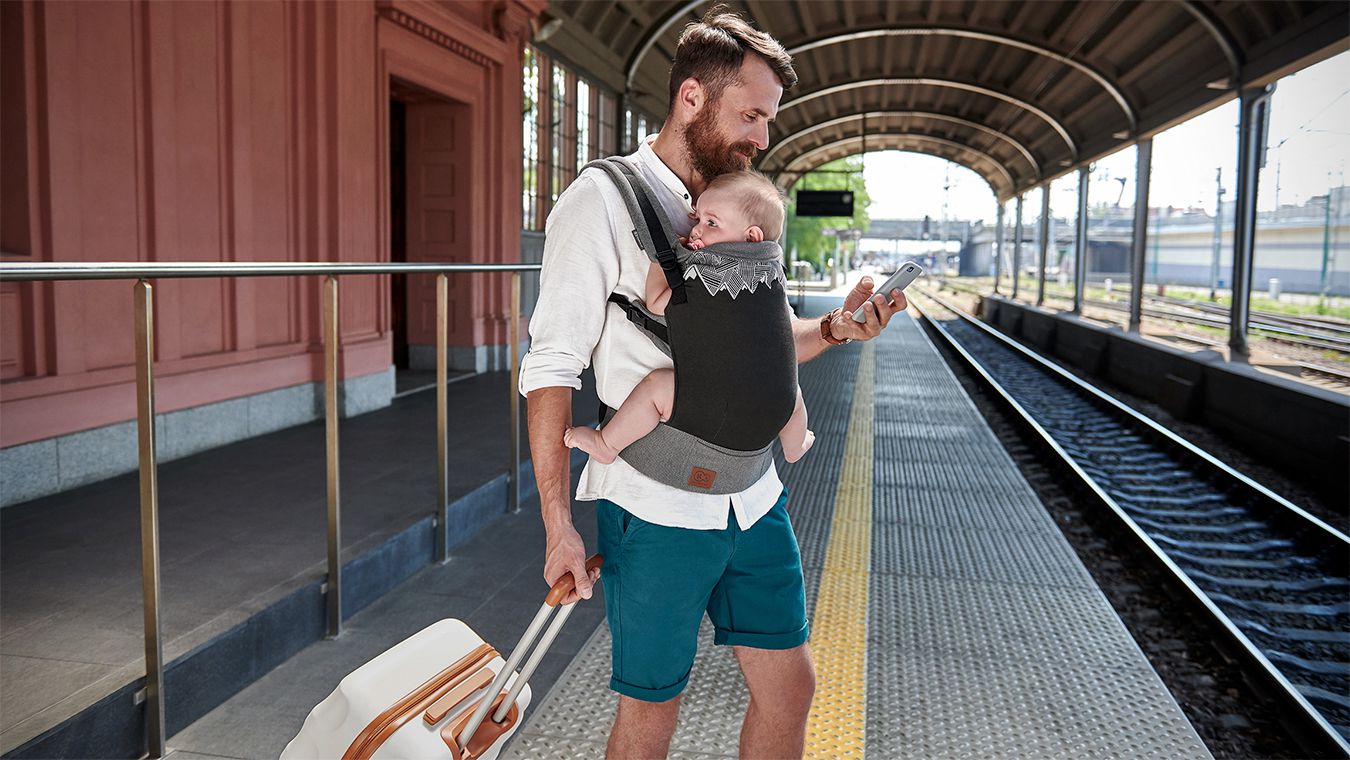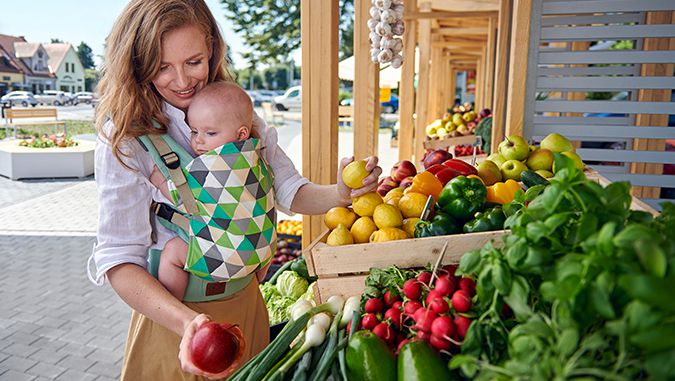The ABCs of babywearing

Which carrying method should I choose for my baby? It can be difficult to find your way among the various baby carriers available on the market. During European Babywearing Week, which runs from 2nd to 8th May, we asked Solène, a physiotherapist specialising in perinatal care, to answer the most frequently asked questions on the subject and to help you make an informed choice.
Can I carry my baby from birth?
Our babies are immature beings at birth. Babywearing is a continuation of pregnancy, provides emotional and sensory security, delineates the baby's body pattern and reduces the MORO reflex. A baby is born to be carried. Some babies require shoulder time more than others. Let's not be afraid to give it to them, and babywearing can help us meet this need.
What are the most important criteria for choosing a physiological baby carrier?
There are two types of carriers, both for babies and for parents (to ensure comfortable carrying). Some are asymmetrical and others are symmetrical.
The asymmetrical ones (wraps) have a strap going over only one shoulder, causing the baby's weight to be distributed over that shoulder only. Very practical from birth, as long as the baby is not too heavy and the carrying time is not too long.
The symmetrical ones (typical carriers) have panels on both shoulders which spread the baby's weight better. They allow you to carry heavier babies for longer (especially when walking). Choose a carrier that suits you both in terms of use and comfort.
Do the properties differ depending on the season?
It is important to know that carrying a baby in a carrier is a way of thermoregulation between baby and parent. Therefore, when the baby is carried, we dress them as if they were at home, and if it is cold, we should put on, for example, a coat or a vest. That's why it's important to choose how to carry your baby depending on the season your baby was born and the region you live in.
Depending on the method of assembly, there may be 3 layers of material in some carriers. Hence, choosing the material of the carrier will be very important.
Depending on the type and material of the carrier/wrap, the knots will also vary.
Do the same carriers work well indoors, i.e. during housework, and outdoors, i.e. while walking?
There are no specific indoor or outdoor carriers. It is not easy to find one that fits the baby and the wearer. Parents who enjoy walking outdoors, in the mountains or in the woods, should choose a symmetrical carrier, where the panel of the carrier reaches the baby's shoulder blades. Avoid all frames that will only increase the amount of pressure between you and your baby, and thus the weight you will have to carry in addition to your baby. Also, protect the parts of your body that are not covered by the carrier (sunscreen in the summer, socks, hat, gloves, etc.).
What is the best position for carrying a baby?
The baby should be in a physiological position. Their pelvis is tilted back (retroversion), which causes the spine to curve (kyphosis), so that the head naturally rests on the chest of the wearer. In case of a newborn, the knees should be joined and slightly higher than the hips. This is the squatting position.
Then, when the baby is able to grasp their feet on their own, which means they have found their hip-width, they can be carried with their hips hip-width apart.
Should a baby be carried facing forward or backward?
A baby can be carried from birth either facing the parent from the front or back. However, a baby placed in front, facing the wearer, is mainly practiced until the age of 5-6 months. The baby's size and its interest in the world around it will prompt us to move them to the wearer's back.
As the wearer, we are more alert to our baby when they are in front. There is an intermediate position, with a support strap, which is asymmetrical but allows the baby to interact with the outside world.
Be careful, carrying your baby facing the world is not recommended. The baby is not in a physiological position, which puts stress on the ossification nuclei. Walking with a baby facing the world provides too much stimulation. The baby cannot take refuge in their carrier. Additionally, this position is not physiological for the wearer (increased tension of the trapezius muscle, pressure on the mother's perineum and increased lumbar lordosis).

How long can a baby stay in the carrier?
It all depends on the baby. Some babies want to be in your arms more than others, in which case carrying them in a carrier will be adequate to free up the parents' arms, meeting the baby's needs and reducing their weight. However, do not forget that a baby also needs movement! When a baby is carried, they do not develop their motor skills. So you need to find the right balance. A happy medium.
How to ensure proper breathing of the baby while wearing?
Follow some safety instructions and stay alert.
When your baby is in the carrier, check that their airway is clear by putting your fingers between their sternum and under their chin. When the baby is not nursing, they should be carried in an upright position. Also check the colour of the baby's hands, feet and face, their temperature (not too hot or too cold), mood and alertness.
What is the parent's proper position while carrying? Should they move more slowly?
A good physiological carrier is one that causes almost no change in the wearer's posture.
A good physiological wrap does not accentuate lumbar lordosis, does not cause shoulder pain, and puts little pressure on the perineum. However, carrying the baby in front or on the back changes the wearer's posture. Also, watch out for door frames! :)

What are the advantages of babywearing?
Babywearing is a continuation of pregnancy. It provides emotional and sensory security that increases oxytocin production, which leads to improved sleep quality.
It is a wonderful thermoregulatory system between the wearer and the baby (the famous "skin to skin"). By responding to your baby's need for closeness, you can reduce crying and anxiety. After birth, the baby does not know the boundaries of their body. Carrying your baby limits them and helps reduce the MORO reflex.
Rocking while walking, while wearing the baby in a carrier, stimulates the immature nervous system, especially one of the balance centres (the vestibular system). Carrying stimulates the postural tension of the torso (especially the cervical spine) and its ability to adapt to changes in position (the child will be more secure and less likely to fall when acquiring the ability to walk).
It also helps prevent and treat torticollis, plagiocephaly and congenital hip dislocation.
Being close to the baby improves lactation in breastfeeding mothers. Facilitates digestion and helps the digestive system mature.
Zonal spinal support takes into account the newborn's curves, which helps prevent spinal deformities. Carrying must respect the baby's rhythm of movement. In parallel with carrying a baby in a wrap, free and floor motor skills should also be used.
Kinderkraft carriers are certified by the International Hip Dysplasia Institute. Can you explain what hip dysplasia is?
Hip dysplasia is a congenital malformation of the hip joint.
It is located between the head of the femur and the hip bone. In LCH, there is a locking defect between the acetabulum and the femoral head. As the name suggests, it is present from birth. To compensate for this lack of femoral head coverage, the baby's hips are placed in abduction and external rotation (legs apart). If suspected, it is in this position that we will be able to place the baby's hips in a carrier until a diagnosis is made.
How is hip dysplasia treated in infants? Will the baby grow up with any sequelae?
Treatment is mainly orthopedic and involves placing the head of the femur in the acetabulum.
This is done by placing the child in a soft diaper, special stabilizer, traction treatment depending on the severity of the identified case.
Orthopedic treatment alone may be sufficient. In rare cases of treatment failure or when the diagnosis was made late, surgery may be performed. The consequences can range from lameness to early osteoarthritis of the hip.
If you have any suspicion of hip dysplasia, you should see a specialist.
What is the difference between a carrier and a wrap and do they have different effects on the health and development of the baby?
A wrap is used from birth until about 8 months of age. Once babies gain motor skills and curiosity about the world, they usually no longer want to be confined in a wrap. In this case it is better to use a baby carrier.
The wrap allows for a sitting position, squatting with knees together, but not the carrier. When the baby is able to grasp their feet (about 3-4 months), they should be offered a carrier with hips apart.
When it comes to carrying your baby facing the world: This type of carrying in a carrier is not recommended. The baby is not in a physiological position, which puts stress on the ossification nuclei. Walking with your baby facing the world provides them with too much stimulation. They cannot take refuge in their carrier. Additionally, this position is not physiological for the wearer (increased tension of the trapezius muscle, pressure on the mother's perineum and increased lumbar lordosis).
As long as the carrying method is physiological for the child and the wearer and compatible with the child's age and motor skills, it does not affect the child's development, but only benefits it.
This content was provided by Solène, a physiotherapist specialising in perinatal care
